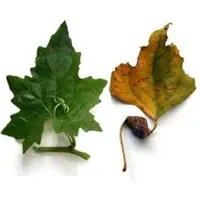Diversity and Decay
Written by

Philip Patston reveals a discovery that literally left him reeling for a moment. After spending twenty years understanding and helping others to understand diversity, he's realised he needs to change his whole direction - from helping people to grow, to letting them decay.
* * *
There was so much I learnt in the recent retreat run by Sue Davidoff and Allan Kaplan of the Proteus Initiative. I want to share another amazing insight, this time about the nature of diversity itself (and when I say "nature" I mean both the phenomena of the physical world and the basic or inherent features of something).
One of the exercises we did was to go and observe plants that were growing and dying (or decaying). We were asked to observe them carefully and then sketch them. Obviously the latter action is not a forté of mine but observation doesn't require much dexterity and I made a discovery that literally left me reeling for a moment. Let me use these two pictures to demonstrate what I saw. Can you see it too?
The first leaf is growing. It has order and structure. If it was on a tree it would have a certain uniformity with the other leaves. It would have a certain uniqueness, but amongst a common shape, colour and texture for that kind of leaf.
The second leaf is dying and decaying. It is random – chaotic even – in shape, colour and texture. If there were more of them each would be totally different.
Do you see what this means? There is more diversity in the process of decaying than in growing.
I don't know about you but I was gob smacked. After spending twenty years understanding and helping others to understand diversity, I realised I needed to change my whole direction. In order to recognise and understand diversity (not create it, as it's already around in abundance), something had to decay in individuals, organisations, communities and humanity, not grow.
The question was, what exactly needs to decay?
It's taken me a few weeks to begin to be clear about a possible answer. So here is what I might call "Diversity in Decay v1.0".
Individuals
In individuals, what needs to decay is identity. In order to recognise your own and others' diversity, you need to let go of your idea of who you are or who you think the other person is. This may include dropping labels, assumptions, values and beliefs. You may hold them dear, but they will lock you into an idea of who you or someone else that is constrained by them. I realised this clearly when I spoke recently to a meeting of Gender Bridge, a community group established to provide support for transgendered people, their friends, families, and communities. In order to successfully understand and/or enter into a process of changing gender identity, you need to decay many things, including the values society places on static, binary notions of gender and your own idea of yourself as your biological or born gender.
Organisations
Most organisations see strategic diversity management as a way to add fairness, variety, competence and productivity to their workforces, services and/or products. They write policies and procedures, do awareness training and even "diversity activities" like putting on ethnic lunches, learning cultural traditions or acknowledging lifestyle differences. All well and good but, in my experience, this attempt to "do" diversity is often inauthentic and usually fails. Why? Because they forget to decay organisational culture – ideas of what is efficient, professional, acceptable and usual. Without losing these old notions of what was important, diversity strategies are token. (I heard a great quote from Tamarack & Vibrant Communities Associate Mark Cabaj a few weeks ago: "Culture eats strategy for breakfast." It is so true in this context.)
Communities
Where communities struggle with diversity, I believe, is in their need to hear or to speak with one voice. In short communities need to decay agreement. Communities tend to need common language, behaviour and structures to create collective identity. Like leaves on a healthy tree they want to foster a certain shape, colour and texture. Unfortunately, diversity within community is about embracing and working with paradox, discomfort and uncertainty. It's messy, frustrating and hard work.
Humanity
Humanity – no pressure. I'm aware I'm at risk of totally destroying my credibility by positing one thing everyone needs to do without, in order to embrace diversity. But what the hell. I'll put it out there. I think the thing that humanity needs to decay is the need for answers. Answers impede the exploration of diversity more than anything else in the world. Once we know (or think we know) the answer to who we are, or who someone else is, or how, or why or when, we stop asking questions. The Diversity Inquiry - or DIVINQ - process I designed a couple of years ago is based on that one simple premise – the need to inquire constantly about our personal and social dynamic.
There you go. Identity, organisational culture, agreement and the need for answers. Four very complex things we need to be prepared to let decay, in order to let diversity grow in abundance.
Not bad for a couple of leaves.
If you'd like to experience the DIVINQ process, I'll be facilitating a conversation in Auckland on 24 August as part of Diversityworks Trust's "How Diversity Works" exhibition. You can learn more about it and register on the Trust's website.